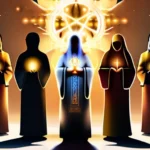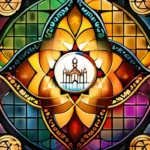Explore the spiritual beliefs and teachings that have shaped the music and life of Bob Dylan, one of the most influential musicians in history.
Bob Dylan is a musical legend whose songs have touched millions of hearts. But beyond his melodies lies a deep spirituality that has influenced his music and shaped his worldview. In this article, we delve into the key teachings of Bob Dylan’s religion, exploring how they have informed his artistry and personal life.
The Influence of Christianity on Bob Dylan’s Music
Bob Dylan’s Religion: The Luminous Path Through Christianity
Bob Dylan, often hailed as one of the most influential musicians in history, has been deeply intertwined with Christianity throughout his career. From his early gospel roots to his later spiritual explorations, how has this religion shaped his music and life? Could it be said that Christianity is the guiding light through which he sees the world?
Consider Dylan’s song Messiah in Mississippi, where he explores themes of redemption and societal injustice. It’s almost as if he’s using the Christian narrative to critique the harsh realities of race relations, isn’t it? How does this interplay between gospel and social commentary reflect his spiritual journey?
The early years of Dylan are marked by a profound interest in traditional American music, including Christian hymns and gospel songs. In these early works, we hear echoes of a musician who is both deeply rooted in the past and striving for something more—like a pilgrim seeking the Holy Grail.
As his career progressed, Dylan’s spiritual explorations became more complex. Albums like ‘New Morning’ and ‘Blonde on Blonde’ delve into personal reflections that echo Christian themes of struggle and grace. Is it possible that these songs are his way of grappling with a personal faith or spirituality?
The influence of Christianity in Dylan’s music is not just about the lyrics; it’s also about the mood, the atmosphere he creates. Think of how his voice can take on different tones when singing religious themes—sometimes solemn, sometimes almost playful. How does this affect listeners who approach his work with a Christian lens?
Ultimately, exploring the role of Christianity in Bob Dylan’s music reveals a rich tapestry of faith and artistry. From his early gospel roots to his later spiritual explorations, each phase tells a story of growth, questioning, and ultimately, a deep connection to something greater than himself. Could it be that through his music, Dylan invites us all on a journey of discovery, much like the path of a seeker in search of enlightenment?
Bob Dylan and Judaism: A Spiritual Journey
Bob Dylan’s music has long been a reflection of his deep-rooted spiritual journey, one that finds its origins in the rich tapestry of Judaism. As we delve into the Jewish influences on Dylan’s work, we can’t help but wonder: how does the complex and multifaceted faith of Judaism shape his unique sound and worldview?
From the opening chords of ‘Blowin’ in the Wind’ to the poetic lyrics of ‘Tangled Up in Blue,’ Dylan’s music often echoes themes rooted in Jewish teachings. His songs are a tapestry woven with threads from the Old Testament, the Talmud, and the broader cultural and historical narratives of Jewish life.
Consider The Times They Are a-Changin’. The title itself is a nod to the prophetic voice found in the Hebrew Bible. Dylan’s lyrics often call for social change and justice, drawing parallels with the ethical imperatives found in Judaism. It’s as if he sees himself not just as a singer-songwriter, but as a modern prophet, using his music as a means to speak truth to power.
The spiritual journey of Bob Dylan is like a pilgrimage through different faiths and beliefs. Just as one might wander through the streets of Jerusalem, exploring its history and holy sites, Dylan wanders through the landscapes of human experience, often finding himself in the shadow of Jewish teachings. His songs become a map, guiding listeners through the labyrinth of his thoughts and feelings.
Moreover, Dylan’s fascination with Judaism is not just about religious doctrine; it’s about exploring the very nature of identity and the human condition. In many of his works, he grapples with themes of exile, redemption, and the search for meaning, all of which have deep roots in Jewish tradition.
By embracing these teachings, Dylan’s music becomes a bridge between the past and the present, bridging the gap between personal struggle and universal human experience. Through his lyrics, we can see how Judaism provides not just religious guidance but also a profound sense of connection to something greater than ourselves.
The Mysticism of Bob Dylan’s Music
Imagine Bob Dylan as a modern-day troubadour, wandering through the landscapes of his soul, singing tales that weave together threads of mysticism and spirituality. How does one begin to explore the mystical themes that have become the very essence of his music? These themes are not just poetic flourishes but profound explorations into the unknown realms of the human experience.
From the moment he stepped onto the stage, Dylan has employed symbolism like a magician using sleight of hand. In songs such as ‘Blowin’ in the Wind,’ the wind becomes a metaphor for change and freedom, hinting at a force that is both invisible yet ever-present. Is this not akin to the way mystics throughout history have sought to explain the unexplainable through imagery and allegory?
The supernatural elements in Dylan’s music are perhaps most vividly portrayed in works like ‘Tombstone Blues,’ where the listener can almost feel the eerie presence of a ghost or hear the echoes of a spectral voice. Are these not just musical devices, or do they serve as windows into another realm, inviting the audience to ponder existence beyond the visible world?
Moreover, Dylan’s exploration of the mystical often intertwines with his personal struggles and reflections on life. In ‘Desolation Row,’ he paints a vivid picture of a city where time is fluid, and reality blurs. Is this not a commentary on the fluidity of human experience, suggesting that our understanding of the world and ourselves is always in flux?
Through these mystical themes, Dylan challenges us to question the nature of reality itself. Are we just navigating through a desolate row, or are there deeper layers to explore? His music invites us to delve into the mysteries of life, urging us to look beyond the surface and seek the profound truths that lie within.
So, as we listen to Dylan’s songs, let us not merely hear words and melodies but also recognize the power of his mysticism. For in his art, he offers a journey through the realms of the heart, mind, and soul, inviting each of us to embark on our own spiritual quest.
Bob Dylan and Eastern Religions: A Search for Enlightenment
Bob Dylan’s journey through Eastern religions, particularly Buddhism and Hinduism, has been a profound exploration that mirrors his search for enlightenment in his music and personal life. How can one delve into such a complex spiritual path without drawing parallels to the quest for understanding one’s place in the world? Buddhism, with its emphasis on the four noble truths and the concept of dukkha (suffering), resonates deeply with Dylan’s lyrics. He often explores themes of struggle, disillusionment, and the search for meaning, all of which are central to Buddhist philosophy.
In his song ‘Like a Rolling Stone,’ Dylan’s raw and direct questioning of societal norms reflects the Buddha’s teachings on the impermanence of life and the dissolution of social constructs. Similarly, Dylan’s interest in Hinduism, with its focus on reincarnation and spiritual liberation (moksha), is evident in his exploration of cyclical themes and his fascination with ancient texts like the Bible.
Through his music, Dylan seems to be seeking a way to transcend the mundane realities of life, much like a seeker in Eastern traditions would strive for enlightenment. His lyrics often carry subtle messages about detachment from materialism and the search for inner peace—ideals that are at the heart of these religions. By incorporating elements of Eastern spirituality into his work, Dylan provides listeners with a multifaceted view of human experience, encouraging them to question their own existence and seek deeper meanings.
His album John Wesley Harding, in particular, is rich with references to Christian symbolism interwoven with Buddhist concepts. The juxtaposition of spiritual imagery from both traditions creates a tapestry that invites listeners to explore the interconnectedness of different belief systems. Through these layers of meaning, Dylan challenges his audience to look beyond surface-level understanding and delve into the profound questions of existence.
Ultimately, Dylan’s engagement with Eastern religions serves as a bridge between Western and non-Western thought, reflecting his own journey towards a more holistic view of spirituality. As he continues to explore these themes in his music, he invites us all on a voyage of self-discovery, urging us to seek our own path toward enlightenment.
The Role of Prophecy in Bob Dylan’s Music
Bob Dylan, often referred to as ‘a modern-day prophet‘, wove prophetic elements into his music, much like a weaver interlaces threads to form a tapestry. Is it any wonder then that his songs resonate so deeply within us? In analyzing the prophetic aspects of his work, we delve into themes of social commentary and spiritual awakening.
From the opening lines of ‘The Times They Are A-Changin’‘, Dylan’s music becomes a clarion call for change. His lyrics act as a mirror, reflecting societal issues and urging listeners to question their world. Is it not the role of a prophet to challenge the status quo? By using vivid imagery and metaphor, he paints a picture of a society in turmoil, calling out for justice and unity.
Biblical imagery is another key element that underscores Dylan’s prophetic stance. In songs like ‘Lie Through Your Teeth‘ and ‘Positively 4th Street‘, he draws on Old Testament stories to deliver his message. Just as the prophets of old used parables and allegories, so too does Dylan use these religious references to convey complex ideas in an accessible way. It’s almost as if he’s speaking directly from the pages of scripture, offering guidance for our times.
One can’t help but wonder about the deeper meaning behind his lyrics. Are they simply artistic expressions or do they carry a divine message? In exploring this question, we see Dylan as both a creator and a messenger, weaving together threads of prophecy with those of personal experience to create a rich tapestry of spiritual truth.
His music serves not just as entertainment but as a call to action, a reminder that each one of us has the power to effect change. In this sense, Dylan’s prophetic role is twofold: he both identifies problems and suggests solutions, offering a vision of a better world through his songs.
So, in the spirit of prophecy, let’s ask ourselves: are we listening? Are we ready to embrace the changes that Dylan so eloquently envisions?
Bob Dylan’s Spiritual Evolution: A Lifelong Journey
Imagine diving into the vast ocean of Bob Dylan’s spiritual journey, where every song is a ship sailing through the uncharted waters of belief and doubt. From his early days as a Christian singer-songwriter to his later explorations of various faiths and beliefs, Dylan’s music has been a reflection of his personal search for meaning.
At the beginning, Dylan wore his Christian faith on his sleeve. Songs like ‘Gotta Serve Somebody’ and ‘Blowin’ in the Wind’ are imbued with biblical imagery and a sense of moral urgency. But as he delved deeper into his craft, the lines between Christianity and other spiritual paths began to blur.
Consider how Dylan’s exploration of Eastern philosophies, such as Zen Buddhism, transformed his music. Songs like ‘Tangled Up in Blue’ and ‘Visions of Johanna’ reflect a more introspective and questioning mind. Could it be that these explorations were a turning point, leading him to question the rigid structures he once held dear?
The shift is palpable in works such as Love and Theft, where Dylan’s lyrics weave together elements of classical poetry with modern themes. Is this not a metaphor for his own spiritual journey, where different paths cross and merge to form a unique path?
Through it all, Dylan remains a figure who embodies the idea that faith is not static but dynamic, ever-changing as one grows and experiences life. His music serves as a testament to this process, inviting listeners to join him on his spiritual voyage.
So, in every note and lyric, we find echoes of his journey—his struggles, his questions, and ultimately, his search for something greater than himself. What does your own spiritual journey look like when viewed through the lens of Dylan’s music?
Conclusion
 By examining the spiritual themes in Bob Dylan’s music, we gain a deeper understanding of his beliefs and their impact on his work. Whether you are a fan of his music or simply curious about his spiritual journey, this article offers valuable insights into the teachings that have shaped one of the most influential musicians of our time.
By examining the spiritual themes in Bob Dylan’s music, we gain a deeper understanding of his beliefs and their impact on his work. Whether you are a fan of his music or simply curious about his spiritual journey, this article offers valuable insights into the teachings that have shaped one of the most influential musicians of our time.











